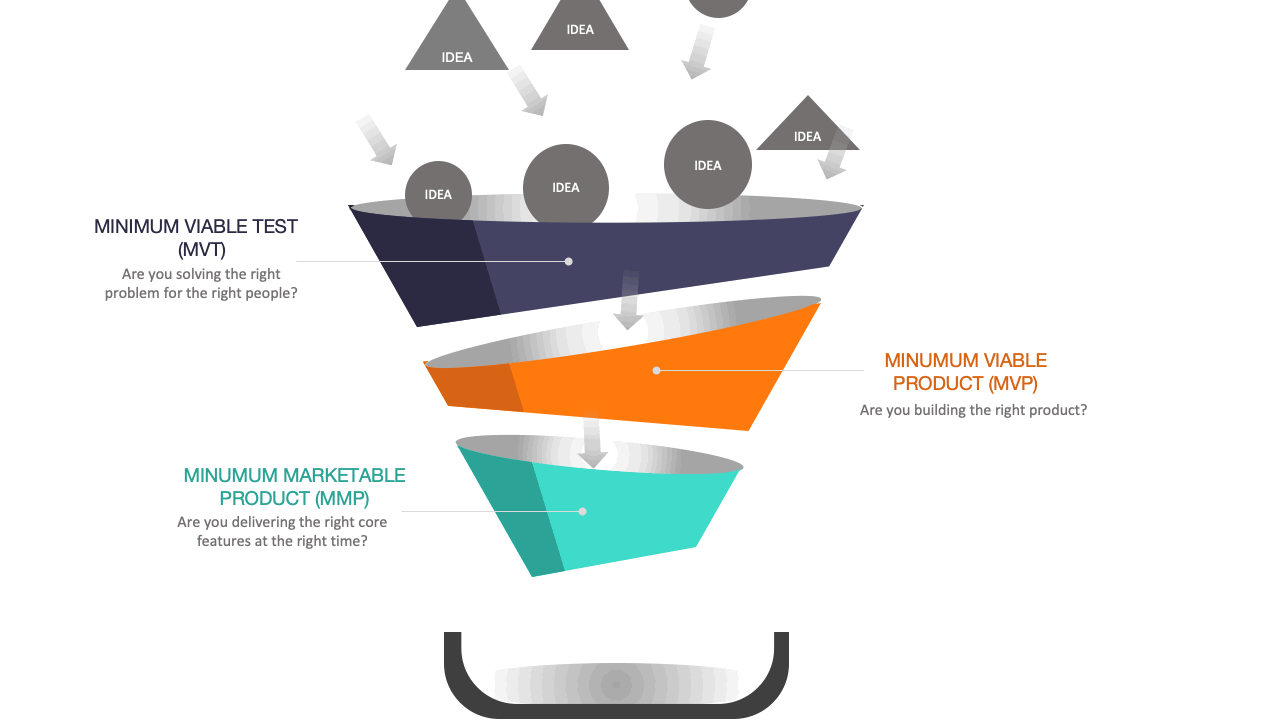When most of us have a great idea, we often fall victim to jumping right into imagining the end product. We get it — it’s hard not to. So many exciting possibilities from what the logo should look like to the user experience to the sound the button will make.
We’ve been there many times and it’s still a hard habit to break. Luckily, there is a proven process — a Product Validation Funnel — that can help investors and founders validate ideas before the big investments are made. Building a product takes time, money, and energy that you can’t afford to waste. As you probably know, 9 out of 10 ventures end up failing, and a good number of them simply do because of burnout with an otherwise solid idea.
There’s a big difference between building the thing right and building the right thing. Far too often, intra- and entrepreneurs spend little to no time mapping out their business idea or validating their idea assumptions.
So, how exactly do you ensure that your idea is a good product-market fit?
The Product Validation Funnel Overview
In a nutshell, the Product Validation Funnel helps you remove as much risk from starting a venture as possible. The principles are built upon concepts from The Lean Startup by Eric Ries, which is a highly recommended reading.
The mistake we see over and over again is that new ventures try to jump from ‘idea’ to ‘building a product’. Although this might seem like a good way to confirm your assumptions, it often leads to frustration because time and money is spent on something that doesn’t get traction.
The Product Validation Funnel helps avoid this scenario by using a systematic methodology that can first prove your idea with a minimum viable test (MVT), then test your idea with a minimum viable product (MVP), and finally launch your idea with a minimal marketable product (MVP).
Being honest with yourself and diligent with these steps will help you effectively and efficiently confirm or deny your idea each step of the way. We can’t promise every idea deserves or warrants a product, but we can promise that using the Product Validation Funnel will help those good ideas to go from zero to one.

Stage 1: Minimal Viable Test (MVT)
Approximate Stage Length: One Week
The first step in the funnel is the MVT stage. Think of the MVT as a “gut-check” or a “temperature-check.” Your main goal is to make sure there is a real, quantifiable appetite for your solution, as well as an actual problem that exists to be solved. We see too many startups try to be perfect, which is why so many resort to going all-in on refining a market-ready product right off the bat to protect their idea from critique.
You need to get messy. There’s no way around it. Be ready to fail and fail some more. Take that mindset and go find out what people really think of your idea and what they want. Here’s some inspiration to get you started.
We’ve all most likely heard of and probably used Dropbox. Dropbox was just an idea at one point in time as crazy as that sounds when you really think about it. Rather than immediately purchasing a bunch of servers and code file-sharing software, Dropbox instead started by making a landing page, sign-up form, and a 2-minute overview video. They sent that out to what they thought would be their target market, and a quarter-million signups later, their product was well pretty safely validated.
Granted, Dropbox was a great idea. But even their industry-changing idea still needed validation. They could have built an entire platform and flopped, possibly setting the file-sharing marketplace back years (maybe we’re being dramatic but we’ll never know).
Now it’s your turn. Think about who your audience should be, find a way to talk to them, and start asking. It’s okay if you don’t have something to give to them right away. That comes next.
Stage 2: Minimal Viable Product (MVP)
Approximate Stage Length: One to Three Months
Now that you’ve confirmed that your idea has interest in the market, it’s time to move on to making a minimal viable product. This does not mean you should start picking out your color scheme. Instead, think of this step as your “bootstrap” phase. What does that mean? By “bootstrap” we mean pulling together resources you already have access to that can be used to soft-launch an idea. We are ideally talking about a no/low-code solution with tools like Google Docs, Airtable, and Survey Monkey. Here’s an example.
Did you know Airbnb started on Craigslist? Before the founder built their website or app that we’ve come to know and love throughout our travels around the globe, you actually had to rent your villa or condo alongside used golf clubs and antiques. The founders of Airbnb weren’t completely sure people would go through with staying in a stranger’s home. To test their “product”, they listed their own apartment multiple times, tracking messages and details in a spreadsheet until they decided it wasn’t a fluke and they could expand with other rentals.
What are the ways you could bring your idea to life with paying customers while still keeping it low/no-code? Experiment with different methods and see what works until you’re confident it’s something that you can consistently repeat.
Before we move on, now that we’re in the middle of the funnel it’s worth mentioning again that not all ideas will make it completely through the product validation funnel. That doesn’t always mean it’s a bad idea. If you were able to validate your idea with an MVT, but not an MVP, you might need to go back to reassess your findings or gather more data before moving on.
Stage 3: Minimal Marketable Product (MMP)
Approximate Stage Length: Three to Twelve Months
After you’ve bootstrapped and proven that your idea is something people will consistently use or pay for, now you are finally ready to start building. But before you go all out, remember that this is a MINIMUM marketable product — meaning, you need to treat this like a prototype, not a polished masterpiece.
One example of creating an MMP would be the first generation iPod launched by Apple in 2001. Apple developed the first-generation iPod in less than a year with its core focus allowing people to take their music locker where ever they went. In the beginning, the iPod held 1,000 songs and was only available for Mac users. After their first minimal marketable product, the iPod took off and more features, capabilities, and updates were continually released. If fact, just nine months after releasing the first generation iPod, Apple released the second generation iPod which included an upgrade in storage, a touch-sensitive wheel, and the ability for Windows PC users to join in. Check out this story to learn more about the lifecycle of the iPod.
Now that you’ve gone through your MVT and your MVP stage, you’ll realize what your prospects and target audience are looking for from your company. Start working with a software development team to formulate a plan based on your findings. You should be addressing the core feature set that is absolutely required to achieve the value proposition of your solution.
When your MMP is ready, release it to the world and keep an open mind.
The Journey of a Venture
As you launch your product remember that this is just the beginning, not the end. Continue to obsessively gather feedback and insight so that you can grow and scale with your audience as well as the problems in the market.
We like to say, “Be married to solving a problem, not to your solution”. In other words, your venture is merely a way to address a problem, so keep your focus on how that problem can be solved no matter where that takes you.
Naturally, your product will evolve as time goes on which means new features and a variety of other endeavors. Luckily, the Product Validation Funnel is not a one-and-done system. It can be applied to a variety of needs as your business grows. Just as you confirmed, rejected, and tested your idea the first time, continue to remove risk and maximize time and money with a proven system every time.



